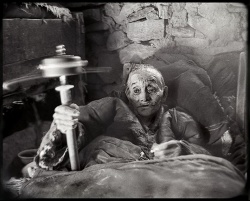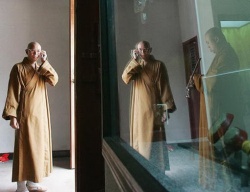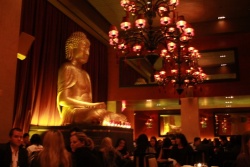Difference between revisions of "A Zen Exploration of the Bahiya Sutta"
(Created page with " <poem> "In the seen, there is only the seen, in the heard, there is only the heard, in the sensed, there is only the sensed, in the cognized,...") |
|||
| Line 1: | Line 1: | ||
| − | + | {{DisplayImages|1808|3578|2280|3554}} | |
<poem> | <poem> | ||
"In the seen, there is only the seen, in the heard, there is only the heard, in the [[sensed]], there is only the [[sensed]], | "In the seen, there is only the seen, in the heard, there is only the heard, in the [[sensed]], there is only the [[sensed]], | ||
| Line 19: | Line 19: | ||
This is however not seen as a problem in other [[traditions]] such as [[Advaita Vedanta]] where the One [[Mind]] is identified with the [[Brahman]] that contains and [[manifests]] the three states of waking, dreaming and deep [[sleep]] within itself, yet remains untouched by its dreamlike [[manifestation]]. | This is however not seen as a problem in other [[traditions]] such as [[Advaita Vedanta]] where the One [[Mind]] is identified with the [[Brahman]] that contains and [[manifests]] the three states of waking, dreaming and deep [[sleep]] within itself, yet remains untouched by its dreamlike [[manifestation]]. | ||
| − | |||
So what has been puzzling me what the [[sense]] of presence, the [[sense]] of being and its [[relation]] with the [[sense]] that things around me [[manifest]] their presence. Over the months I [[realized]] that if this beingness seems to be located as the center of our being, it is actually the flavor of all things. | So what has been puzzling me what the [[sense]] of presence, the [[sense]] of being and its [[relation]] with the [[sense]] that things around me [[manifest]] their presence. Over the months I [[realized]] that if this beingness seems to be located as the center of our being, it is actually the flavor of all things. | ||
| Line 55: | Line 54: | ||
[http://awakeningtoreality.blogspot.com.au/search/label/Alex%20Weith awakeningtoreality.blogspot.com.au] | [http://awakeningtoreality.blogspot.com.au/search/label/Alex%20Weith awakeningtoreality.blogspot.com.au] | ||
[[Category:Sutras]] | [[Category:Sutras]] | ||
| + | [[Category:Zen]] | ||
Revision as of 01:25, 23 February 2014
"In the seen, there is only the seen, in the heard, there is only the heard, in the sensed, there is only the sensed,
in the cognized, there is only the cognized. Thus you should see that indeed there is no thing here;
this, Bahiya, is how you should train yourself. Since, Bahiya, there is for you
in the seen, only the seen, in the heard, only the heard, in the sensed, only the sensed,
in the cognized, only the cognized, and you see that there is no thing here,
you will therefore see that indeed there is no thing there. As you see that there is no thing there,
you will see that you are therefore located neither in the world of this,
nor in the world of that, nor in any place betwixt the two.
This alone is the end of suffering.” (Ud. 1.10)
There is no end to the process of awakening, but in Zen Buddhism there are steps and strategies. These introductory posts will explain my position, what I discovered so far, and how it unfolds.
Having got hold of the ox, one has realized the One Mind. In Zen literature this One Mind has often been compared to a bright mirror that reflects phenomena and yet remains untouched by appearances. As discussed with one of Sheng-yen's first Western students, this One Mind is still an illusion. One is not anymore identified to the self-center, ego and personality, yet one (the man) is still holding to pure non-dual awareness (the ox). Having tamed the ox, the ox-herder must let go of the ox (ox forgotten) and then forget himself and the ox (ox and man forgotten).
The problem is that we still maintain a subtle duality between what we know ourself to be, a pure non-dual awareness that is not a thing, and our daily existence often marked by self-contractions. Hoping to get more and more identified with pure non-dual awareness, we may train concentration, try to hold on to the event of awakening reifying an experience, or rationalize the whole thing to conclude that self-contraction is not a problem and that suffering is not suffering because our true nature is ultimately beyond suffering. This explains why I got stuck in what Zen calls "stagnating waters" for about a year.
This is however not seen as a problem in other traditions such as Advaita Vedanta where the One Mind is identified with the Brahman that contains and manifests the three states of waking, dreaming and deep sleep within itself, yet remains untouched by its dreamlike manifestation.
So what has been puzzling me what the sense of presence, the sense of being and its relation with the sense that things around me manifest their presence. Over the months I realized that if this beingness seems to be located as the center of our being, it is actually the flavor of all things.
Reading the blog "Awakening to Reality" that has become my main source of inspiration, I realized that this presence felt as the presence of 'what is' is the *luminosity* that the Mahamudra teachings are talking about. Gradually, feeling my own sense of being has become feeling the beingness of all things, leading to a deeper non-dual realization that gradually colapsed the sense of a Primoridal Awareness, True Self, or Bright Mirror into what is present here and now.
The conclusion is that all phenomena are in themself empty and luminous, ungraspable and self-aware, ever changing and alive. The conclusion is also that there is nothing beyond that; no permanent pure potential beyond phenomena, no true self that would be the source and substance of phenomena and above all no primordial awareness or Consciousness that would contain the five aggregates.
The whole universe is contained and expressed in a the "cypress tree in the court", simply because in the absence of a super Self in the background, the cypress tree brightly present in this very moment is the absolute reality made manifest in its suchness (tathata). Most Zen koans point to this realization, together with Hui-neng poem "Fundamentally no wisdom-tree exists, Nor the stand of a mirror bright. Since all is empty from the beginning, Where can the dust alight".
Surprizingly this deconstruction leads to a deeper level of non-duality. Huang-po's "One Mind' is starting to become Mazu's "No Mind, no Buddha".
.............
Practically speaking this means:
1). becoming aware of one's sense of existence and focusing on it until it starts to feel as if the only reality is this pure presence-awareness containing everything;
2). shifting this sense of being-existence-presence-awareness to apprehend the beingness of all things, until everything starts to feel bright, luminous, present and alive. At this stage, there is no more "self" and "other", nor is there any subtle duality between primordial awareness and phenomena arising and passing away within it. There is only "seeing seeing the seen" without a seer, nor solid material objects behind the seen.
This does not mean that there is absolutely no Primordial Awareness, Self or One Mind. This would be an extreme position rejected by the Buddha. This explains why the Buddha remained silent when asked about the existence of a Self. Answering "Yes" would mean that there is an eternal abiding inherent essence beyond phenomena (eternalism), while answering "No" would lead to nihilism, the other extreme view. The Buddha's way is the middle way, between these two extremes. There is a self, but this self is an conventional concept to describe something that appears to be and is experienced as such, but it not an abiding ultimate reality.
There is a Mind, but this Mind is empty [of an abiding essence]. This Mind is the *non-abiding mind* of the Diamond Sutra. Therefore, *Mind* is *No Mind*.
This also means that the first step is to disembed from impermanent phenomena until the only thing that feels real is this all pervading uncreated all pervading awareness that feels like the source and substance of phenomena. Holding on to it after this realization can hower become a subtle form of grasping diguised as letting go.
The second step is therefore to realize that this brightness, awakeness or luminosity is there very nature of phenomena and then only does the duality between the True Self and the appearences arising and passing within the Self dissolve, revealing the suchness of what is.
The next step that I found very practical is to push the process of deconstruction a step further, realizing that all that is experienced is one of the six consciousness. In other words, there is neither a super Awareness beyond phenomena, not solid material objects, but only six streams of sensory experiences. The seen, the heard, the sensed, the tasted, the smelled and the cognized (including thoughts, emotions, and subtle thougths like absorbtion states, jhanas).
At this point it is not difficult to see how relevent the Bahiya Sutta can become.



